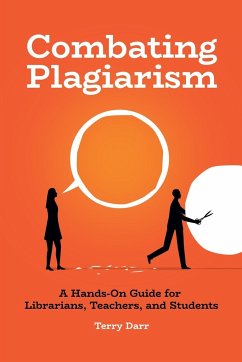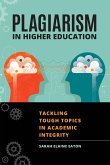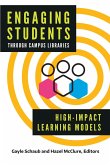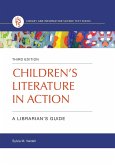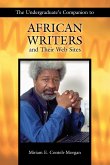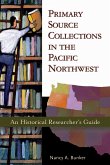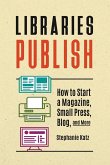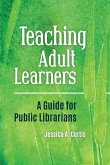- Broschiertes Buch
- Merkliste
- Auf die Merkliste
- Bewerten Bewerten
- Teilen
- Produkt teilen
- Produkterinnerung
- Produkterinnerung
Offers an instructional plan for plagiarism education for middle school and high school students, allowing librarians to become a resource for students, teachers, and school administrators. The proliferation of resources now available through libraries and the internet requires a new set of information management skills in order for students to avoid plagiarism. While educators legitimately expect students to approach academic work with honesty and integrity, students need to be able to understand the context of their academic resources-both print and digital-well enough to use them…mehr
Andere Kunden interessierten sich auch für
![Plagiarism in Higher Education Plagiarism in Higher Education]() Sarah EatonPlagiarism in Higher Education83,99 €
Sarah EatonPlagiarism in Higher Education83,99 €![Engaging Students through Campus Libraries Engaging Students through Campus Libraries]() Engaging Students through Campus Libraries78,99 €
Engaging Students through Campus Libraries78,99 €![Children's Literature in Action Children's Literature in Action]() Sylvia VardellChildren's Literature in Action70,99 €
Sylvia VardellChildren's Literature in Action70,99 €![The Undergraduate's Companion to African Writers and Their Web Sites The Undergraduate's Companion to African Writers and Their Web Sites]() Miriam Conteh-MorganThe Undergraduate's Companion to African Writers and Their Web Sites45,99 €
Miriam Conteh-MorganThe Undergraduate's Companion to African Writers and Their Web Sites45,99 €![Primary Source Collections in the Pacific Northwest Primary Source Collections in the Pacific Northwest]() Nancy BunkerPrimary Source Collections in the Pacific Northwest63,99 €
Nancy BunkerPrimary Source Collections in the Pacific Northwest63,99 €![Libraries Publish Libraries Publish]() Stephanie KatzLibraries Publish67,99 €
Stephanie KatzLibraries Publish67,99 €![Teaching Adult Learners Teaching Adult Learners]() Jessica CurtisTeaching Adult Learners67,99 €
Jessica CurtisTeaching Adult Learners67,99 €-
-
-
Offers an instructional plan for plagiarism education for middle school and high school students, allowing librarians to become a resource for students, teachers, and school administrators. The proliferation of resources now available through libraries and the internet requires a new set of information management skills in order for students to avoid plagiarism. While educators legitimately expect students to approach academic work with honesty and integrity, students need to be able to understand the context of their academic resources-both print and digital-well enough to use them appropriately and ethically. Combating Plagiarism helps middle and high school teachers and librarians understand and teach the authorship and publication process so students learn to use relevant information in an ethically and academically sound fashion. Terry Darr's long-term collaboration with a high school history teacher taught her the challenges faced by students conducting research-and by librarians and teachers tasked with teaching plagiarism prevention. Her book is full of tested concepts for teaching these complex topics, emphasizing our modern reliance on digital sources. An extensive student reference section covers common knowledge, fact, and opinion. A wealth of practical resources includes real-life examples from research papers as well as plenty of instructional materials, exercises, and lesson plans.
Hinweis: Dieser Artikel kann nur an eine deutsche Lieferadresse ausgeliefert werden.
Hinweis: Dieser Artikel kann nur an eine deutsche Lieferadresse ausgeliefert werden.
Produktdetails
- Produktdetails
- Verlag: Bloomsbury Publishing plc
- Seitenzahl: 324
- Erscheinungstermin: 30. September 2019
- Englisch
- Abmessung: 234mm x 156mm x 18mm
- Gewicht: 494g
- ISBN-13: 9781440865466
- ISBN-10: 1440865469
- Artikelnr.: 55524030
- Herstellerkennzeichnung
- Libri GmbH
- Europaallee 1
- 36244 Bad Hersfeld
- gpsr@libri.de
- Verlag: Bloomsbury Publishing plc
- Seitenzahl: 324
- Erscheinungstermin: 30. September 2019
- Englisch
- Abmessung: 234mm x 156mm x 18mm
- Gewicht: 494g
- ISBN-13: 9781440865466
- ISBN-10: 1440865469
- Artikelnr.: 55524030
- Herstellerkennzeichnung
- Libri GmbH
- Europaallee 1
- 36244 Bad Hersfeld
- gpsr@libri.de
Terry Darr
Acknowledgments Introduction Chapter 1. The State of Plagiarism Today The
Online Community Plagiarism Perceptions Plagiarism in Schools The Role of
Instruction for Plagiarism Education Plagiarism Education Instruction
Writing and Plagiarism Librarians as Plagiarism Education Teachers The New
Plagiarism: Challenges with Sources Books Digital Sources Research
Databases Web Pages The New Skill Set Required by Digital Sources Citations
Citation Tools Digital Source Information Management Alternatives to
Printing Advice for Students Tools Advice for Teachers and Librarians
Formatting Information Retrieval and Synthesis Paraphrasing Proofreading
The Authorship and Publication Cycle for Digital Sources Turnitin.com
Conclusion References Chapter 2. Paraphrasing and Micro-Paraphrasing
Micro-Paraphrasing Prerequisite Skills for Paraphrasing The
Micro-Paraphrasing Process The Micro-Paraphrasing Teaching Process:
Preparing for Instruction Active Instruction: Phase One Active Instruction:
Phase Two Student Examples Conclusion Chapter 3. Plagiarism Conversations
Structuring the Discussion Explaining Plagiarism Categories of Plagiarism
Questions Practical Plagiarism Questions Group Work Questions Plagiarism
Questions for College-Bound High School Seniors and First-Year College
Students Teacher Questions about Plagiarism Academic Integrity Questions
Moral Plagiarism Questions Conclusion References Chapter 4. Citations
Citation Basics The Citation Is the Source Types of Resources: Finding the
Citation Information Print Books MLA APA Chicago Notes and Bibliography
Chicago Author-Date Advice for Teachers and Librarians about Print Books
Digital Sources Web Pages MLA: Web Page Articles APA: Web Page Articles
Chicago Notes and Bibliography: Web Page Articles Chicago Author-Date: Web
Page Articles Research Database Articles MLA: Scholarly Journal Research
Database Article APA: Scholarly Journal Research Database Article Chicago
Author-Date Scholarly Journal Research Database Article Chicago
Notes-Bibliography Scholarly Journal Citation MLA Research Database
Reference Source Article Citation-No Author MLA Research Database Reference
Source Citation-Author APA Research Database Reference Source Article
Citation-No Author APA Research Database Reference Source Article
Citation-Author Chicago Author-Date Research Database Reference Source
Article Citation-No Author Chicago Author-Date Research Database Reference
Source Article Citation-Author Chicago Notes and Bibliography Research
Database Reference Source Article Citation-No Author Chicago Notes and
Bibliography Research Database Reference Source Article Citation-Author
Breaking down Citations Building Visual Familiarity of Citations: Advice
for Teachers and Librarians Citation Guides Advice for Students about
Citation Guides Advice for Teachers about Citation Guides Advice for
Teachers: Teaching Citations Librarians Teaching Citations Online Citation
Tools Online Citation Tools: Advice for Librarians Online Citation Tools:
Advice for Teachers Online Citation Tools: Advice for Students Resources
Chapter 5. Reducing Plagiarism in the Classroom Teacher and Librarian
Collaborations Advice for Teachers about Collaborations for Plagiarism
Education Advice for Librarians about Collaborations for Plagiarism
Education Strategies for Reducing Plagiarism in the Classroom Advice for
Teachers The Use of Secondary Sources to Reduce Plagiarism Plagiarism
Problems and Solutions Citations and Plagiarism Advice for Teachers: When
to Expect Citations from Students Recognizing Plagiarism through Citation
Errors Proofreading to Avoid Plagiarism Advice for Teachers Advice for
Librarians Advice for Students Proofreading Guidelines A Note about
Citation Tools and Proofreading Title Formats References/Bibliography/Works
Cited Page Parenthetical Citations and Footnotes Direct Quotes and
Paraphrases Direct Quotes Direct Quote Parenthetical Citations and
Footnotes Paraphrases Paraphrase Parenthetical Citations and Footnotes
Block Quotes Review the Teacher's Grading Rubric and Assignment
Expectations Reviewing a Rubric More Proofreading Guidelines: Advice for
Students Integrating Plagiarism Education Advice for Teachers Advice for
Librarians: Leading the Way with Plagiarism Education Librarians: Helping
Students Who Have Plagiarized References Chapter 6. Student Resources A New
Way to Look at Plagiarism The Internet Catching Plagiarism How Do You Know
You Are Running the Risk of Plagiarism? Types of Information Common
Knowledge Relevant and Irrelevant Information Ideas, Facts, and Opinions
Examples of Ideas and Opinions What's a Fact? Recognizing Digital Source
Parts Titles of Reference Books and Specialized Encyclopedias Titles of
Magazines and Newspapers Research Database Articles: Scholarly Journal
Titles Websites: Article Titles and Web Page Titles Volume and Issue Number
Book Publishers What Types of Information Need a Citation? Authors and
Editors Recognizing Authors in a Citation MLA Chicago (Notes and
Bibliography) Chicago (Author-Date) APA MLA Chicago (Notes and
Bibliography) Chicago (Author-Date) APA Author Name Formats Editors MLA APA
Chicago Title Formats Italics versus Quotation Marks for Titles MLA Chicago
Author-Date and Notes-Bibliography APA Dates and Page Numbers Locating
Publication Dates for Sources Books Web Pages Research Database Articles
Publication Date versus Copyright Date Accessed Dates for Digital Sources
Month Abbreviations Date Variations Date Variations for Parenthetical
Citations Page Numbers in Sources Nonstandard Sources Quotations and
Paraphrasing Block Quotes MLA APA Chicago Author-Date Chicago Notes and
Bibliography Placing a Quote or Paraphrase in the Text of Your Paper MLA:
Direct Quote from a Research Database Article MLA: Paraphrase APA: Direct
Quote APA: Paraphrase Chicago Author-Date: Direct Quote Chicago Notes and
Bibliography: Direct Quote Chicago Author-Date: Paraphrase Chicago Notes
and Bibliography: Paraphrase Micro-Paraphrasing The Mechanics of Plagiarism
Copy and Paste These Errors Are Not Considered Plagiarism (But You'll
Probably Lose Points) Plagiarism Problems and Solutions Other Practical
Ways to Avoid Plagiarism Honor Policies and Honor Agreements You Have Been
Accused of Plagiarism: What Should You Do? Resources Chapter 7. Common
Knowledge Common Knowledge and Plagiarism Recognizing Common Knowledge
Reading Sources with Attention to Detail Advice for Teachers: What Do Your
Students Know? Class Examples Advice for Students No Citation Required:
Common Knowledge or Background Knowledge Needs a Citation: Not Common
Knowledge Reference Chapter 8. Digital Images Advice for Teachers about
Digital Images Categories of Digital Images Google Images Digital
Collections Citations for Digital Images Google Images MLA Examples APA
Examples Chicago Author-Date Examples Chicago Notes and Bibliography
Examples Advice for Librarians about Digital Images Advice for Students
about Digital Images Reference Resources Conclusion Appendix A: The Anatomy
of a Web Page Appendix B: Identify the Parts of the Citation Appendix C:
The Anatomy of a Research Database Article Appendix D: Can You Spot the
Problems? Citation Proofreading Appendix E: Citation Guides Appendix F:
Final Documentation Lists Appendix G: General Citation Style Reviews
Appendix H: Explaining Plagiarism Appendix I: Common Knowledge Glossary
Index
Online Community Plagiarism Perceptions Plagiarism in Schools The Role of
Instruction for Plagiarism Education Plagiarism Education Instruction
Writing and Plagiarism Librarians as Plagiarism Education Teachers The New
Plagiarism: Challenges with Sources Books Digital Sources Research
Databases Web Pages The New Skill Set Required by Digital Sources Citations
Citation Tools Digital Source Information Management Alternatives to
Printing Advice for Students Tools Advice for Teachers and Librarians
Formatting Information Retrieval and Synthesis Paraphrasing Proofreading
The Authorship and Publication Cycle for Digital Sources Turnitin.com
Conclusion References Chapter 2. Paraphrasing and Micro-Paraphrasing
Micro-Paraphrasing Prerequisite Skills for Paraphrasing The
Micro-Paraphrasing Process The Micro-Paraphrasing Teaching Process:
Preparing for Instruction Active Instruction: Phase One Active Instruction:
Phase Two Student Examples Conclusion Chapter 3. Plagiarism Conversations
Structuring the Discussion Explaining Plagiarism Categories of Plagiarism
Questions Practical Plagiarism Questions Group Work Questions Plagiarism
Questions for College-Bound High School Seniors and First-Year College
Students Teacher Questions about Plagiarism Academic Integrity Questions
Moral Plagiarism Questions Conclusion References Chapter 4. Citations
Citation Basics The Citation Is the Source Types of Resources: Finding the
Citation Information Print Books MLA APA Chicago Notes and Bibliography
Chicago Author-Date Advice for Teachers and Librarians about Print Books
Digital Sources Web Pages MLA: Web Page Articles APA: Web Page Articles
Chicago Notes and Bibliography: Web Page Articles Chicago Author-Date: Web
Page Articles Research Database Articles MLA: Scholarly Journal Research
Database Article APA: Scholarly Journal Research Database Article Chicago
Author-Date Scholarly Journal Research Database Article Chicago
Notes-Bibliography Scholarly Journal Citation MLA Research Database
Reference Source Article Citation-No Author MLA Research Database Reference
Source Citation-Author APA Research Database Reference Source Article
Citation-No Author APA Research Database Reference Source Article
Citation-Author Chicago Author-Date Research Database Reference Source
Article Citation-No Author Chicago Author-Date Research Database Reference
Source Article Citation-Author Chicago Notes and Bibliography Research
Database Reference Source Article Citation-No Author Chicago Notes and
Bibliography Research Database Reference Source Article Citation-Author
Breaking down Citations Building Visual Familiarity of Citations: Advice
for Teachers and Librarians Citation Guides Advice for Students about
Citation Guides Advice for Teachers about Citation Guides Advice for
Teachers: Teaching Citations Librarians Teaching Citations Online Citation
Tools Online Citation Tools: Advice for Librarians Online Citation Tools:
Advice for Teachers Online Citation Tools: Advice for Students Resources
Chapter 5. Reducing Plagiarism in the Classroom Teacher and Librarian
Collaborations Advice for Teachers about Collaborations for Plagiarism
Education Advice for Librarians about Collaborations for Plagiarism
Education Strategies for Reducing Plagiarism in the Classroom Advice for
Teachers The Use of Secondary Sources to Reduce Plagiarism Plagiarism
Problems and Solutions Citations and Plagiarism Advice for Teachers: When
to Expect Citations from Students Recognizing Plagiarism through Citation
Errors Proofreading to Avoid Plagiarism Advice for Teachers Advice for
Librarians Advice for Students Proofreading Guidelines A Note about
Citation Tools and Proofreading Title Formats References/Bibliography/Works
Cited Page Parenthetical Citations and Footnotes Direct Quotes and
Paraphrases Direct Quotes Direct Quote Parenthetical Citations and
Footnotes Paraphrases Paraphrase Parenthetical Citations and Footnotes
Block Quotes Review the Teacher's Grading Rubric and Assignment
Expectations Reviewing a Rubric More Proofreading Guidelines: Advice for
Students Integrating Plagiarism Education Advice for Teachers Advice for
Librarians: Leading the Way with Plagiarism Education Librarians: Helping
Students Who Have Plagiarized References Chapter 6. Student Resources A New
Way to Look at Plagiarism The Internet Catching Plagiarism How Do You Know
You Are Running the Risk of Plagiarism? Types of Information Common
Knowledge Relevant and Irrelevant Information Ideas, Facts, and Opinions
Examples of Ideas and Opinions What's a Fact? Recognizing Digital Source
Parts Titles of Reference Books and Specialized Encyclopedias Titles of
Magazines and Newspapers Research Database Articles: Scholarly Journal
Titles Websites: Article Titles and Web Page Titles Volume and Issue Number
Book Publishers What Types of Information Need a Citation? Authors and
Editors Recognizing Authors in a Citation MLA Chicago (Notes and
Bibliography) Chicago (Author-Date) APA MLA Chicago (Notes and
Bibliography) Chicago (Author-Date) APA Author Name Formats Editors MLA APA
Chicago Title Formats Italics versus Quotation Marks for Titles MLA Chicago
Author-Date and Notes-Bibliography APA Dates and Page Numbers Locating
Publication Dates for Sources Books Web Pages Research Database Articles
Publication Date versus Copyright Date Accessed Dates for Digital Sources
Month Abbreviations Date Variations Date Variations for Parenthetical
Citations Page Numbers in Sources Nonstandard Sources Quotations and
Paraphrasing Block Quotes MLA APA Chicago Author-Date Chicago Notes and
Bibliography Placing a Quote or Paraphrase in the Text of Your Paper MLA:
Direct Quote from a Research Database Article MLA: Paraphrase APA: Direct
Quote APA: Paraphrase Chicago Author-Date: Direct Quote Chicago Notes and
Bibliography: Direct Quote Chicago Author-Date: Paraphrase Chicago Notes
and Bibliography: Paraphrase Micro-Paraphrasing The Mechanics of Plagiarism
Copy and Paste These Errors Are Not Considered Plagiarism (But You'll
Probably Lose Points) Plagiarism Problems and Solutions Other Practical
Ways to Avoid Plagiarism Honor Policies and Honor Agreements You Have Been
Accused of Plagiarism: What Should You Do? Resources Chapter 7. Common
Knowledge Common Knowledge and Plagiarism Recognizing Common Knowledge
Reading Sources with Attention to Detail Advice for Teachers: What Do Your
Students Know? Class Examples Advice for Students No Citation Required:
Common Knowledge or Background Knowledge Needs a Citation: Not Common
Knowledge Reference Chapter 8. Digital Images Advice for Teachers about
Digital Images Categories of Digital Images Google Images Digital
Collections Citations for Digital Images Google Images MLA Examples APA
Examples Chicago Author-Date Examples Chicago Notes and Bibliography
Examples Advice for Librarians about Digital Images Advice for Students
about Digital Images Reference Resources Conclusion Appendix A: The Anatomy
of a Web Page Appendix B: Identify the Parts of the Citation Appendix C:
The Anatomy of a Research Database Article Appendix D: Can You Spot the
Problems? Citation Proofreading Appendix E: Citation Guides Appendix F:
Final Documentation Lists Appendix G: General Citation Style Reviews
Appendix H: Explaining Plagiarism Appendix I: Common Knowledge Glossary
Index
Acknowledgments Introduction Chapter 1. The State of Plagiarism Today The
Online Community Plagiarism Perceptions Plagiarism in Schools The Role of
Instruction for Plagiarism Education Plagiarism Education Instruction
Writing and Plagiarism Librarians as Plagiarism Education Teachers The New
Plagiarism: Challenges with Sources Books Digital Sources Research
Databases Web Pages The New Skill Set Required by Digital Sources Citations
Citation Tools Digital Source Information Management Alternatives to
Printing Advice for Students Tools Advice for Teachers and Librarians
Formatting Information Retrieval and Synthesis Paraphrasing Proofreading
The Authorship and Publication Cycle for Digital Sources Turnitin.com
Conclusion References Chapter 2. Paraphrasing and Micro-Paraphrasing
Micro-Paraphrasing Prerequisite Skills for Paraphrasing The
Micro-Paraphrasing Process The Micro-Paraphrasing Teaching Process:
Preparing for Instruction Active Instruction: Phase One Active Instruction:
Phase Two Student Examples Conclusion Chapter 3. Plagiarism Conversations
Structuring the Discussion Explaining Plagiarism Categories of Plagiarism
Questions Practical Plagiarism Questions Group Work Questions Plagiarism
Questions for College-Bound High School Seniors and First-Year College
Students Teacher Questions about Plagiarism Academic Integrity Questions
Moral Plagiarism Questions Conclusion References Chapter 4. Citations
Citation Basics The Citation Is the Source Types of Resources: Finding the
Citation Information Print Books MLA APA Chicago Notes and Bibliography
Chicago Author-Date Advice for Teachers and Librarians about Print Books
Digital Sources Web Pages MLA: Web Page Articles APA: Web Page Articles
Chicago Notes and Bibliography: Web Page Articles Chicago Author-Date: Web
Page Articles Research Database Articles MLA: Scholarly Journal Research
Database Article APA: Scholarly Journal Research Database Article Chicago
Author-Date Scholarly Journal Research Database Article Chicago
Notes-Bibliography Scholarly Journal Citation MLA Research Database
Reference Source Article Citation-No Author MLA Research Database Reference
Source Citation-Author APA Research Database Reference Source Article
Citation-No Author APA Research Database Reference Source Article
Citation-Author Chicago Author-Date Research Database Reference Source
Article Citation-No Author Chicago Author-Date Research Database Reference
Source Article Citation-Author Chicago Notes and Bibliography Research
Database Reference Source Article Citation-No Author Chicago Notes and
Bibliography Research Database Reference Source Article Citation-Author
Breaking down Citations Building Visual Familiarity of Citations: Advice
for Teachers and Librarians Citation Guides Advice for Students about
Citation Guides Advice for Teachers about Citation Guides Advice for
Teachers: Teaching Citations Librarians Teaching Citations Online Citation
Tools Online Citation Tools: Advice for Librarians Online Citation Tools:
Advice for Teachers Online Citation Tools: Advice for Students Resources
Chapter 5. Reducing Plagiarism in the Classroom Teacher and Librarian
Collaborations Advice for Teachers about Collaborations for Plagiarism
Education Advice for Librarians about Collaborations for Plagiarism
Education Strategies for Reducing Plagiarism in the Classroom Advice for
Teachers The Use of Secondary Sources to Reduce Plagiarism Plagiarism
Problems and Solutions Citations and Plagiarism Advice for Teachers: When
to Expect Citations from Students Recognizing Plagiarism through Citation
Errors Proofreading to Avoid Plagiarism Advice for Teachers Advice for
Librarians Advice for Students Proofreading Guidelines A Note about
Citation Tools and Proofreading Title Formats References/Bibliography/Works
Cited Page Parenthetical Citations and Footnotes Direct Quotes and
Paraphrases Direct Quotes Direct Quote Parenthetical Citations and
Footnotes Paraphrases Paraphrase Parenthetical Citations and Footnotes
Block Quotes Review the Teacher's Grading Rubric and Assignment
Expectations Reviewing a Rubric More Proofreading Guidelines: Advice for
Students Integrating Plagiarism Education Advice for Teachers Advice for
Librarians: Leading the Way with Plagiarism Education Librarians: Helping
Students Who Have Plagiarized References Chapter 6. Student Resources A New
Way to Look at Plagiarism The Internet Catching Plagiarism How Do You Know
You Are Running the Risk of Plagiarism? Types of Information Common
Knowledge Relevant and Irrelevant Information Ideas, Facts, and Opinions
Examples of Ideas and Opinions What's a Fact? Recognizing Digital Source
Parts Titles of Reference Books and Specialized Encyclopedias Titles of
Magazines and Newspapers Research Database Articles: Scholarly Journal
Titles Websites: Article Titles and Web Page Titles Volume and Issue Number
Book Publishers What Types of Information Need a Citation? Authors and
Editors Recognizing Authors in a Citation MLA Chicago (Notes and
Bibliography) Chicago (Author-Date) APA MLA Chicago (Notes and
Bibliography) Chicago (Author-Date) APA Author Name Formats Editors MLA APA
Chicago Title Formats Italics versus Quotation Marks for Titles MLA Chicago
Author-Date and Notes-Bibliography APA Dates and Page Numbers Locating
Publication Dates for Sources Books Web Pages Research Database Articles
Publication Date versus Copyright Date Accessed Dates for Digital Sources
Month Abbreviations Date Variations Date Variations for Parenthetical
Citations Page Numbers in Sources Nonstandard Sources Quotations and
Paraphrasing Block Quotes MLA APA Chicago Author-Date Chicago Notes and
Bibliography Placing a Quote or Paraphrase in the Text of Your Paper MLA:
Direct Quote from a Research Database Article MLA: Paraphrase APA: Direct
Quote APA: Paraphrase Chicago Author-Date: Direct Quote Chicago Notes and
Bibliography: Direct Quote Chicago Author-Date: Paraphrase Chicago Notes
and Bibliography: Paraphrase Micro-Paraphrasing The Mechanics of Plagiarism
Copy and Paste These Errors Are Not Considered Plagiarism (But You'll
Probably Lose Points) Plagiarism Problems and Solutions Other Practical
Ways to Avoid Plagiarism Honor Policies and Honor Agreements You Have Been
Accused of Plagiarism: What Should You Do? Resources Chapter 7. Common
Knowledge Common Knowledge and Plagiarism Recognizing Common Knowledge
Reading Sources with Attention to Detail Advice for Teachers: What Do Your
Students Know? Class Examples Advice for Students No Citation Required:
Common Knowledge or Background Knowledge Needs a Citation: Not Common
Knowledge Reference Chapter 8. Digital Images Advice for Teachers about
Digital Images Categories of Digital Images Google Images Digital
Collections Citations for Digital Images Google Images MLA Examples APA
Examples Chicago Author-Date Examples Chicago Notes and Bibliography
Examples Advice for Librarians about Digital Images Advice for Students
about Digital Images Reference Resources Conclusion Appendix A: The Anatomy
of a Web Page Appendix B: Identify the Parts of the Citation Appendix C:
The Anatomy of a Research Database Article Appendix D: Can You Spot the
Problems? Citation Proofreading Appendix E: Citation Guides Appendix F:
Final Documentation Lists Appendix G: General Citation Style Reviews
Appendix H: Explaining Plagiarism Appendix I: Common Knowledge Glossary
Index
Online Community Plagiarism Perceptions Plagiarism in Schools The Role of
Instruction for Plagiarism Education Plagiarism Education Instruction
Writing and Plagiarism Librarians as Plagiarism Education Teachers The New
Plagiarism: Challenges with Sources Books Digital Sources Research
Databases Web Pages The New Skill Set Required by Digital Sources Citations
Citation Tools Digital Source Information Management Alternatives to
Printing Advice for Students Tools Advice for Teachers and Librarians
Formatting Information Retrieval and Synthesis Paraphrasing Proofreading
The Authorship and Publication Cycle for Digital Sources Turnitin.com
Conclusion References Chapter 2. Paraphrasing and Micro-Paraphrasing
Micro-Paraphrasing Prerequisite Skills for Paraphrasing The
Micro-Paraphrasing Process The Micro-Paraphrasing Teaching Process:
Preparing for Instruction Active Instruction: Phase One Active Instruction:
Phase Two Student Examples Conclusion Chapter 3. Plagiarism Conversations
Structuring the Discussion Explaining Plagiarism Categories of Plagiarism
Questions Practical Plagiarism Questions Group Work Questions Plagiarism
Questions for College-Bound High School Seniors and First-Year College
Students Teacher Questions about Plagiarism Academic Integrity Questions
Moral Plagiarism Questions Conclusion References Chapter 4. Citations
Citation Basics The Citation Is the Source Types of Resources: Finding the
Citation Information Print Books MLA APA Chicago Notes and Bibliography
Chicago Author-Date Advice for Teachers and Librarians about Print Books
Digital Sources Web Pages MLA: Web Page Articles APA: Web Page Articles
Chicago Notes and Bibliography: Web Page Articles Chicago Author-Date: Web
Page Articles Research Database Articles MLA: Scholarly Journal Research
Database Article APA: Scholarly Journal Research Database Article Chicago
Author-Date Scholarly Journal Research Database Article Chicago
Notes-Bibliography Scholarly Journal Citation MLA Research Database
Reference Source Article Citation-No Author MLA Research Database Reference
Source Citation-Author APA Research Database Reference Source Article
Citation-No Author APA Research Database Reference Source Article
Citation-Author Chicago Author-Date Research Database Reference Source
Article Citation-No Author Chicago Author-Date Research Database Reference
Source Article Citation-Author Chicago Notes and Bibliography Research
Database Reference Source Article Citation-No Author Chicago Notes and
Bibliography Research Database Reference Source Article Citation-Author
Breaking down Citations Building Visual Familiarity of Citations: Advice
for Teachers and Librarians Citation Guides Advice for Students about
Citation Guides Advice for Teachers about Citation Guides Advice for
Teachers: Teaching Citations Librarians Teaching Citations Online Citation
Tools Online Citation Tools: Advice for Librarians Online Citation Tools:
Advice for Teachers Online Citation Tools: Advice for Students Resources
Chapter 5. Reducing Plagiarism in the Classroom Teacher and Librarian
Collaborations Advice for Teachers about Collaborations for Plagiarism
Education Advice for Librarians about Collaborations for Plagiarism
Education Strategies for Reducing Plagiarism in the Classroom Advice for
Teachers The Use of Secondary Sources to Reduce Plagiarism Plagiarism
Problems and Solutions Citations and Plagiarism Advice for Teachers: When
to Expect Citations from Students Recognizing Plagiarism through Citation
Errors Proofreading to Avoid Plagiarism Advice for Teachers Advice for
Librarians Advice for Students Proofreading Guidelines A Note about
Citation Tools and Proofreading Title Formats References/Bibliography/Works
Cited Page Parenthetical Citations and Footnotes Direct Quotes and
Paraphrases Direct Quotes Direct Quote Parenthetical Citations and
Footnotes Paraphrases Paraphrase Parenthetical Citations and Footnotes
Block Quotes Review the Teacher's Grading Rubric and Assignment
Expectations Reviewing a Rubric More Proofreading Guidelines: Advice for
Students Integrating Plagiarism Education Advice for Teachers Advice for
Librarians: Leading the Way with Plagiarism Education Librarians: Helping
Students Who Have Plagiarized References Chapter 6. Student Resources A New
Way to Look at Plagiarism The Internet Catching Plagiarism How Do You Know
You Are Running the Risk of Plagiarism? Types of Information Common
Knowledge Relevant and Irrelevant Information Ideas, Facts, and Opinions
Examples of Ideas and Opinions What's a Fact? Recognizing Digital Source
Parts Titles of Reference Books and Specialized Encyclopedias Titles of
Magazines and Newspapers Research Database Articles: Scholarly Journal
Titles Websites: Article Titles and Web Page Titles Volume and Issue Number
Book Publishers What Types of Information Need a Citation? Authors and
Editors Recognizing Authors in a Citation MLA Chicago (Notes and
Bibliography) Chicago (Author-Date) APA MLA Chicago (Notes and
Bibliography) Chicago (Author-Date) APA Author Name Formats Editors MLA APA
Chicago Title Formats Italics versus Quotation Marks for Titles MLA Chicago
Author-Date and Notes-Bibliography APA Dates and Page Numbers Locating
Publication Dates for Sources Books Web Pages Research Database Articles
Publication Date versus Copyright Date Accessed Dates for Digital Sources
Month Abbreviations Date Variations Date Variations for Parenthetical
Citations Page Numbers in Sources Nonstandard Sources Quotations and
Paraphrasing Block Quotes MLA APA Chicago Author-Date Chicago Notes and
Bibliography Placing a Quote or Paraphrase in the Text of Your Paper MLA:
Direct Quote from a Research Database Article MLA: Paraphrase APA: Direct
Quote APA: Paraphrase Chicago Author-Date: Direct Quote Chicago Notes and
Bibliography: Direct Quote Chicago Author-Date: Paraphrase Chicago Notes
and Bibliography: Paraphrase Micro-Paraphrasing The Mechanics of Plagiarism
Copy and Paste These Errors Are Not Considered Plagiarism (But You'll
Probably Lose Points) Plagiarism Problems and Solutions Other Practical
Ways to Avoid Plagiarism Honor Policies and Honor Agreements You Have Been
Accused of Plagiarism: What Should You Do? Resources Chapter 7. Common
Knowledge Common Knowledge and Plagiarism Recognizing Common Knowledge
Reading Sources with Attention to Detail Advice for Teachers: What Do Your
Students Know? Class Examples Advice for Students No Citation Required:
Common Knowledge or Background Knowledge Needs a Citation: Not Common
Knowledge Reference Chapter 8. Digital Images Advice for Teachers about
Digital Images Categories of Digital Images Google Images Digital
Collections Citations for Digital Images Google Images MLA Examples APA
Examples Chicago Author-Date Examples Chicago Notes and Bibliography
Examples Advice for Librarians about Digital Images Advice for Students
about Digital Images Reference Resources Conclusion Appendix A: The Anatomy
of a Web Page Appendix B: Identify the Parts of the Citation Appendix C:
The Anatomy of a Research Database Article Appendix D: Can You Spot the
Problems? Citation Proofreading Appendix E: Citation Guides Appendix F:
Final Documentation Lists Appendix G: General Citation Style Reviews
Appendix H: Explaining Plagiarism Appendix I: Common Knowledge Glossary
Index

